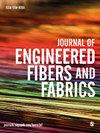纸浆模塑材料的本构模型及实验研究
IF 2.3
4区 工程技术
Q1 MATERIALS SCIENCE, TEXTILES
引用次数: 0
摘要
纸浆模塑产品可以提高再生纸的利用率,实现接近于零的废弃物排放和100%的回收率,同时满足各国包装材料再生的国家目标。纸浆模塑产品通常采用有限元模拟来优化其性能,这需要输入准确的材料性能。然而,本构模型作为影响材料性能的重要因素,其相关研究尚不多见。为了简化纸浆模塑材料的参数,提高本构模型的准确性,本研究对纸浆模塑材料的力学行为进行了研究。研究了纸浆模塑材料内部纤维的分布和连接;将纸浆模塑的孔隙视为虚拟材料,增强了纸浆模塑的细观力学模型,得到了横向各向同性的本构模型。厚度方向的弹性模量计算值为1.5997 MPa,实验实测值为1.5368 MPa。该模型的误差为4.1%,但明显小于将纸浆作为各向同性材料处理,误差是实验结果的80倍左右。本文章由计算机程序翻译,如有差异,请以英文原文为准。
Constitutive model and experimental study of molded pulp material
Molded pulp products can improve the utilization of recycled paper by achieving close to zero waste emission and a 100% recycling rate, while satisfying the national goals for recycled packaging materials of various countries. Molded pulp products are often designed using finite-element simulations to optimize their performance, which requires the input of accurate material properties. However, studies on the constitutive model, an essential factor related to material properties, are still rare. This study investigated the mechanical behavior of the molded pulp material to simplify the parameters and improve the accuracy of the constitutive model. The fiber distribution and connection within the molded pulp material were investigated; treating the pores of the molded pulp as a virtual material enhances the meso-mechanical model and gives a transversely isotropic constitutive model. The elastic modulus in the thickness direction was calculated as 1.5997 MPa, and the experimentally measured value is 1.5368 MPa. The error of proposed model is 4.1%, but significantly smaller than treating molded pulp as an isotropic material, the error of which is ~80 times larger of experimental result.
求助全文
通过发布文献求助,成功后即可免费获取论文全文。
去求助
来源期刊

Journal of Engineered Fibers and Fabrics
工程技术-材料科学:纺织
CiteScore
5.00
自引率
6.90%
发文量
41
审稿时长
4 months
期刊介绍:
Journal of Engineered Fibers and Fabrics is a peer-reviewed, open access journal which aims to facilitate the rapid and wide dissemination of research in the engineering of textiles, clothing and fiber based structures.
 求助内容:
求助内容: 应助结果提醒方式:
应助结果提醒方式:


